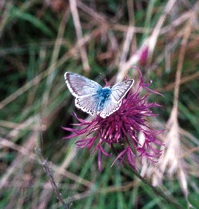Butterflies

Butterflies depend on the flower-rich downland for their survival.
The rare blue butterflies Common Blue, Small Blue, Chalk-hill Blue and Adonis Blue depend on small blue plants of the pea family as food plants for their caterpillars. More common are species whose caterpillars feed on grasses, such as the brown butterflies Meadow Brown and Small Heath, and the black and white Marbled White. Other butterflies that may be seen are the Large and Small White, Small Skipper and Small Copper, although these are not dependant on downland for their survival. The rare Duke of Burgundy Fritillary occurs mainly in the woods of the eastern Ridgeway. Its caterpillars feed on cowslips, oxlips and primroses.
A couple of day-flying moths may be seen: the Burnet and Cinnabar Moths.
SHEEPDROVE RARE BUTTERFLY PROJECT
Sheepdrove Organic Farm north of Lambourn is conducting an ambitious conservation project to help save rare butterflies. The Project’s top priorities are the Marsh Fritillary, the Small Blue and the Chalkhill Blue. As the Farm is not far from The Ridgeway, it would be possible for the butterflies to reach The Ridgeway and establish colonies there in the future. The growing conditions on The Ridgeway favour the food plant of the Small Blue, i.e. Kidney Vetch, which grows on poor chalk soil in the sun. The butterflies lay their eggs in the flowers and subsequent caterpillars live off the plant. At Sheepdrove the Project has attracted Small Blues by creating ‘crescents’ of bare chalk ground and seeding Kidney Vetch in them. This could be done on The Ridgeway above Sheepdrove, which is only about 2 miles away, a distance within range of the Small Blues. The crescents do not need to be very big, perhaps 6′ x 4′ sloping towards the south.
